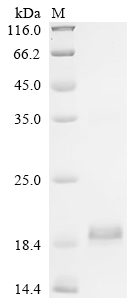The gene fragment encoding the 237-350aa of human INHBE protein is expressed with an INHBE protein 6xHis tag gene in an E. coli system. A high-expression vector acting as a carrier for the expressed gene is introduced into E. coli cells for protein expression. The expressed protein is the recombinant INHBE protein, which is isolated and purified using Ni-NTA affinity chromatography from the cell lysate. The recombinant INHBE protein is analyzed by SDS-PAGE, confirming a purity greater than 90%.
The human inhibin beta E chain, encoded by the INHBE gene, is a member of the inhibin/activin family, which is part of the larger TGF-β superfamily. Inhibins, including inhibin beta E, are produced by the gonads and play critical roles in the regulation of follicle-stimulating hormone (FSH) secretion from the pituitary gland, thereby influencing reproductive processes [1][2].
Inhibin beta E is unique among the inhibin subunits due to its specific expression patterns and potential roles in various physiological and pathological contexts. It has been implicated in the regulation of ovarian function and has been studied in the context of ovarian diseases and cancers. Inhibin beta E can form heterodimers with the inhibin alpha subunit, contributing to the overall biological activity of inhibins [3][4]. Additionally, it is involved in signaling pathways that regulate cell growth and differentiation, particularly in the context of reproductive tissues [5].
Recent studies have highlighted the differential expression of inhibin beta E in various cancers, suggesting its potential as a biomarker for malignancies. Alterations in the expression of inhibin beta E have been observed in cervical cancer, indicating its involvement in tumor biology [3].
References:
[1] M. M’Baye, G. Hua, H. Khan, & L. Yang, Rnai-mediated knockdown of <i>inhbb</i> increases apoptosis and inhibits steroidogenesis in mouse granulosa cells, Journal of Reproduction and Development, vol. 61, no. 5, p. 391-397, 2015. https://doi.org/10.1262/jrd.2014-158
[2] I. Mylonas, U. Jeschke, I. Wiest, A. Hoeing, J. Vogl, N. Shabani, et al. Inhibin/activin subunits alpha, beta-a and beta-b are differentially expressed in normal human endometrium throughout the menstrual cycle, Histochemistry and Cell Biology, vol. 122, no. 5, p. 461-471, 2000. https://doi.org/10.1007/s00418-004-0709-6
[3] F. Bergauer, A. Brüning, N. Shabani, T. Blankenstein, J. Jückstöck, D. Dian, et al. Inhibin/activin-betae subunit in normal and malignant human cervical tissue and cervical cancer cell lines, Journal of Molecular Histology, vol. 40, no. 5-6, p. 353-359, 2009. https://doi.org/10.1007/s10735-009-9246-x
[4] M. Lei, L. Cai, H. Li, Z. Chen, & Z. Shi, Transcriptome sequencing analysis of porcine granulosa cells treated with an anti-inhibin antibody, Reproductive Biology, vol. 17, no. 1, p. 79-88, 2017. https://doi.org/10.1016/j.repbio.2017.01.002
[5] A. Kita, A. Kasamatsu, D. Nakashima, Y. Endo‐Sakamoto, S. Ishida, T. Shimizu, et al. Activin b regulates adhesion, invasiveness, and migratory activities in oral cancer: a potential biomarker for metastasis, Journal of Cancer, vol. 8, no. 11, p. 2033-2041, 2017. https://doi.org/10.7150/jca.18714






